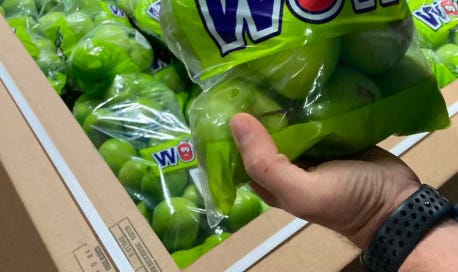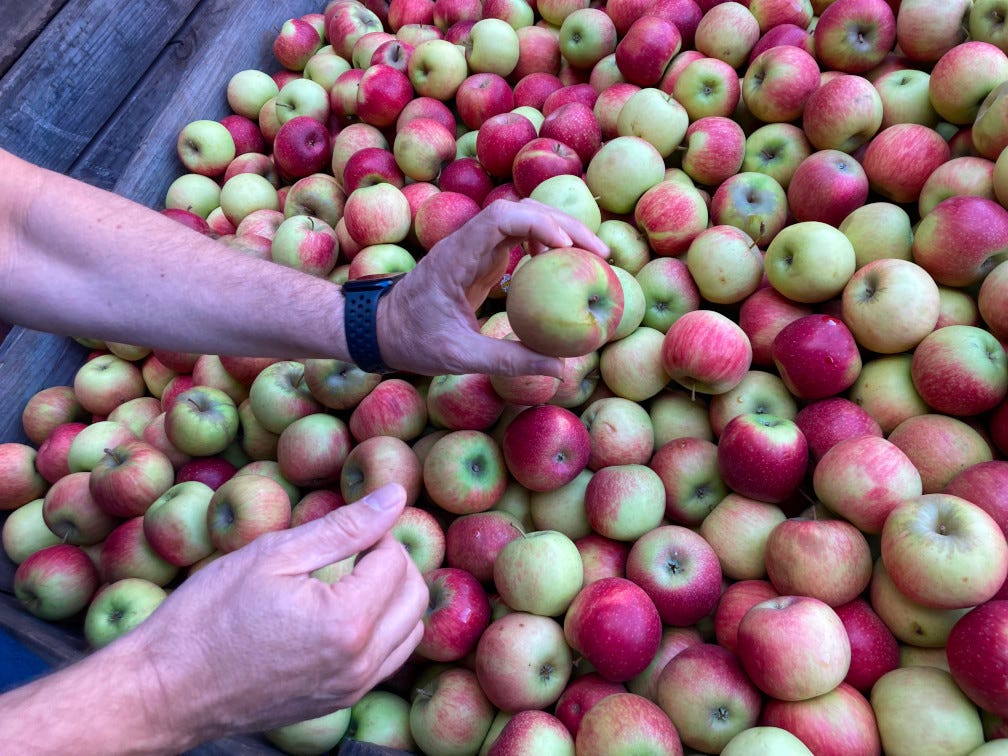Adventures in the apple trade
From discovering and decoding new varieties of apples (and pears) to growing, packing, marketing and exporting them, South Africa packs a punch with other heavy hitters in the global pome industry
When you put a piece of fruit into your mouth, all you need is a little bit of mindfulness to be aware: 'I am putting a piece of apple in my mouth.’ Your mind doesn’t need to be somewhere else. If you’re thinking of work while you chew, that’s not eating mindfully. When you pay attention to the apple, that is mindfulness. Then you can look more deeply and in just a very short time you will see the apple seed, the beautiful orchard and the sky, the farmer, the picker, and so on. A lot of work is in that apple!
– from page one of Zen teacher Thich Nhat Hanh’s mindfulness book How To Eat
Finding them apples
If you were to eat an apple a day, but a different varietal of apple every day, it would take you more than twenty years to get through them all. And by that stage there would undoubtedly be many more to bite into.
Buks Nel’s job is to find those new varietals and January 18 in 2011 proved a particularly productive date on that score. “I remember the day,” he says. He was strolling through the orchards at Oak Valley Estate in Elgin looking for “funny things that are not the same” and he found one: a Gala mutation.
“I walk the orchards and I see the same fruit all the time as I go down the row. Then all of a sudden I see a branch that’s different. It may be redder or greener or bigger or smaller in fruit. With Bigbucks it was quite easy because it stood out like a sore thumb.”
And so with Oak Valley proprietor Anthony Rawbone-Viljoen and Derek Corder, the owner of Beaulieu Farm, the three of them applied for plant breeders’ rights (PBR) and developed the variety. From then till now, 1500 to 2000 hectares of that red apple – Bigbucks – have been planted and the first commercial volumes are coming through. Nel recalls that Calla du Toit, a grower in Ceres, had said: “Come on, let’s call it ‘Bigbucks’. It sounds like your name.”
Owning or having shared PBR is a highly desirable situation in the fruit industry. It means that club variety can only be planted if royalties are paid to the company responsible for discovering it – in this case to Tru-Cape Fruit Marketing, the largest exporter of South African apples and pears. Nel is Tru-Cape’s new variety specialist.
The fruit was trademarked as Flash Gala (Bigbucks is the variety name). Essentially, the best examples of Bigbucks become Flash Gala: if an apple has 80 percent of the required colour, it’s a Flash Gala. If only 60 percent, it’s sold as Bigbucks.
2011 turned out to be a bonanza year on the commercial strain front. Two months later, Nel found and applied for PBR for two other commercially viable mutations he discovered in Elgin: Fuji Royal and Shortie. These mutations are always given code names to kick off with, he says. Fuji Royal started life as Viagra B – “just that I can remember it” – and Shortie, redder and smaller, started off as Viagra A.
‘There are so many new apples coming out now’
Buks Nel, Tru-Cape new variety specialist
Nel trained as an entomologist, “a gogga man”, as he describes it (“gogga”, pronounced with guttural “g’s”, is South African slang for insect). He started his career in a chemical company working on crop protection, doing trials with new insecticides through a university.
He moved to the Two-a-Day fruit packhouse and exporter in 1975 as a technical advisor, mainly on crop protection and later on “with everything”. He retired at 60 and then his career as a new variety specialist on apples and pears began, a role he’s been stuck into for the last 22 years –“and that’s been the most fulfilling time of my life, I think.
“They said, ‘Buks, you’re very interested in apple varieties and pear varieties. Let’s make a little job for you,’” he recalls. “I’ve travelled the whole world; I’ve seen the world through new varieties. It’s been fun.”
Kazakhstan is the origin of the modern apple. There are forests of wild apple trees there – yellow, green, red, big, small – and Nel has walked “for the experience” some of those 100 000 hectares in the mountains between Kazakhstan and China. Scientists found that the apples there have exactly the same DNA sequencing as “the apple that you buy in Pick n Pay”, he says.
Pears, on the other hand, haven’t changed as much from a varietal point of view: there are far fewer of them. Chinese varieties of pears continue to be much easier to eat than the European pears people are more familiar with in other parts of the world that need to ripen first (as the 19th century American writer and philosopher Ralph Waldo Emerson wrote, “There are only ten minutes in the life of a pear when it is perfect to eat”). Far East pears are a totally different type of pear though: crunchy, not buttery like ours, Nel adds.
“An apple should have a crunch, whether it tastes nice or not. That’s very important in an apple. It’s not important in a peach or a plum or a pear, but an apple should be crunchy.”
Industry terms mentioned above
Grower Farmers has a live-stock connotation, so people who grow apples and pears are called growers.
Club variety A registered and branded type of fruit that meets a specified colour and earns a premium price. Flash Gala and Pink Lady are club varieties.
Packhouse A building where fruit cleaning, sorting, packing and storing takes place before distribution.
Assessing them apples
In the development of an apple from seed to fruit, a mutation is a mistake. It could be initiated by an environmental factor such as astral radiation. It could be a gene fault: along the timeline of division, the mechanism of the transcription of a gene makes an error. The mistake could occur at the beginning of the process, where the whole fruit winds up looking different from its peers; in the middle of the process; or at the end, such as the result of a very defined, out-of-place stripe on a flower.
With apples, these mutations constitute the same variety, they just look different: that visual difference is the evidence of a single gene that has mutated. A whole new type of apple, though, can only be created through plant crosses – sexual propagation – and that stems from seed and a mixture of genes. On a mutation on a mature tree, the tissue has already matured. So it’s a much quicker process to commercialise fruit from a mutation, as a new apple crossed from seed takes about seven years to bear fruit.
‘A lot of the times you find the mutations in the bin, not on the tree. Nothing can be done at that point: you don’t know where it came from.’
Henk Griessel, Tru-Cape quality assurance manager
Having said that, new apple varieties from crosses is “big business now”, says Henk Griessel, Tru-Cape’s quality assurance manager. There are many hundreds of different apple species/varieties available commercially that have been created from crosses, although this process can happen in nature too.
“Let’s say you’re looking for a specific characteristic: I want a red-fleshed crunchy apple that tastes nice. That’s a very difficult thing because the red flesh normally has a very high tannin content – it’s really not nice to eat. Then they’ll make thousands of crosses and then they taste them all once they start bearing. Eventually, if they find something that is pleasant, then they start propagating that.”
Before the process of sexual propagation for plants was understood or known by man – and exactly when and where that took place is not easy to pinpoint – agricultural developers never knew what the connection was between pollen and stigma.
Because seeds are all genetically different, apple trees aren’t planted from seed because farm owners want apple orchards where all the trees look the same and, also, orchards that operate like factories, utilising the light as efficiently as possible. “So you design the number of rows, the distance between the trees, the distance between the rows. All those things because you work towards a certain size of tree.”
In addition, a seedling has to go through a “youth phase”, so in working with seed one waits longer to get into production. “You want to start off with mature material which is why you start off with the rootstock. And rootstock has its added advantages like disease resistance. Rootstock with disease resistance can then be multiplied.”
Industry terms mentioned above
Bin A box in which the picked apples and pears are transported to the packhouse.
Rootstock A variety which is propagated for a specific reason to function as the roots of a plant.
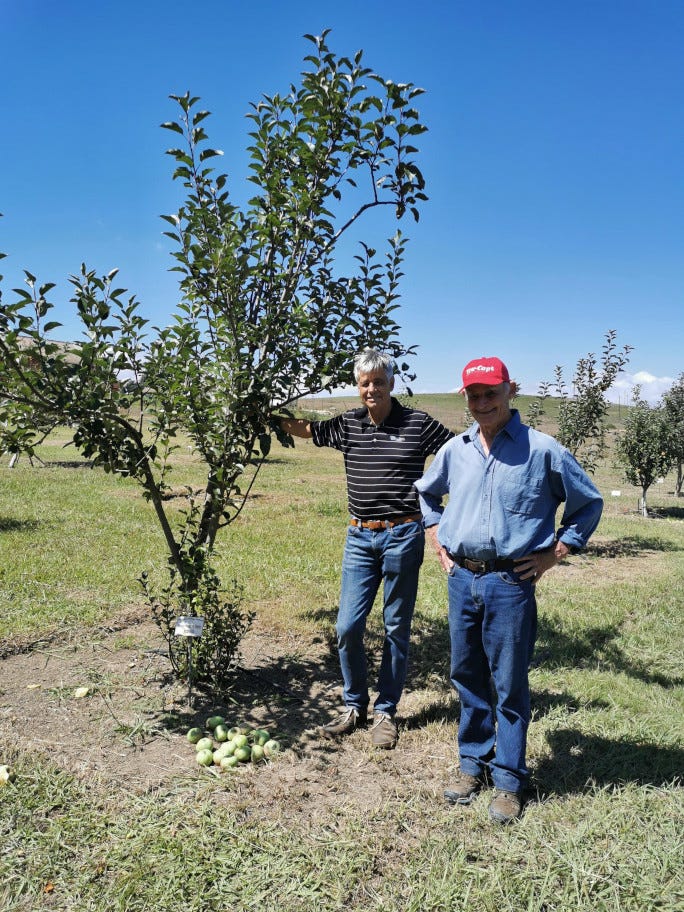
Growing them apples
When James Corder’s grandfather was running the show at Beaulieu Farm in Grabouw, he generally worked with only three apple varieties: Golden Delicious, Granny Smith and Top Red (Starking was the precursor to Top Red).
“It served them very well but times have changed,” says Corder as he walks through the 68 hectares (when fully planted) that he now oversees with his father, Derek, who took over the running of the farm from his father. James’ great-grandfather bought the farm.
There are many fruit farms in Grabouw, a predominantly apple and pear farming area in the Elgin Valley about an hour’s drive from Cape Town, varying in size from four hectares to hundreds of hectares. “We generally fall into the small to medium size farm in this area,” Corder says.
The varieties farmed here now continue to include Golden Delicious, Granny Smith and Top Red, as well as Royal Gala and Bigbucks, Fuji, Kanzi, Pink Lady and Rosy Glow (the latter two are club varieties that fall under the Braeburn cultivar). Harvesting begins in the first week of February until the second or third week of May, “and then everything is sent to Two-a-Day and they basically take it from there” (Two-a-Day is one of three large packhouses in the area with Kromco and Fruitways, plus there are smaller independent ones).
‘You need a specific type of climate for apples and pears and this is the climate that works’
James Corder, co-owner with his father, Derek, of Beaulieu Farm in Grabouw
Apples, it turns out, are highly delicate and grabbing them on a tree with one’s fingers and yanking them off is a farming no-no. The resultant bruising could transform a first-grade apple with a perfect finish on a tree into a third-grade apple in the packing box.
The harvesting process is “a whole other thing itself”, Corder says. Pickers pick with the palms of their hands and lift the apples up. The apples are then gently placed in the picking bag. Then the bottom of the picking bag is opened and the apples are gently put into the bin. “That’s the theory,” Corder says. “When you see someone going and picking with the tips of their fingers, you know that’s generally going to bruise the fruit.”

Pears have a lot more resistance to bruising – “which is not to say you can be rough”, he’s quick to add. Pear trees are also hardier, making them ideal candidates for marginal sites and soils where apple trees won’t thrive.
Perhaps pears tend to generate less buzz than apples because they haven’t had quite the proliferation of varieties as apples have had. The pears that have always been grown are still being grown. Forelle, for example, is one of four varieties of pears grown in South Africa. It was developed in Germany and introduced to SA in the 1800s. Packham’s Triumph, Abate Fetel and Cheeky (one of the newer varieties) are the others, and Corder says there is also a little bit of Rosemarie on the farm, a little bit of Bon Chretien and Clapp’s Favourite. For Abate Fetels, 60 tonnes a hectare “is a good year for us”.
But apples are the main event at Beaulieu and all new plantings are apple because apples come into production quicker. While apple trees require a lot more attention and are more susceptible to fungal diseases – even insect and pest diseases – they make a little bit more money.
In 2021, Beaulieu had a record apple crop. The Kanzi orchard produced 135 tonnes a hectare. “There is the fine balance between quantity and quality. I would always want to be getting at least 75-80 tonnes a hectare.”

He has a pear orchard on the farm that is going into year 10 now and still hasn’t yielded much, whereas growers can start getting “somewhat of a return” from year three, break even by year five to six, and begin to make money by year seven with apple orchards.
“Pears take time to find their feet. But then once they’re settled, in general the longevity of a pear orchard is longer. Once that orchard comes into production, it could be there for the next 40 years.” Corder says there are pear orchards on the farm that are almost 60 years old.
Packing them apples
The South African apple industry is roughly one and a half percent of the world apple industry but it’s usually on the list of top exporters. “So we’re a very small portion of world production but always in the top 10 exporting countries and that tells a story. We are very competitive in terms of our apple industry,” says Attie van Zyl, managing director of Two-a-Day Group, the Grabouw-based fruit packer and storage facility and shareholder of Tru-Cape.
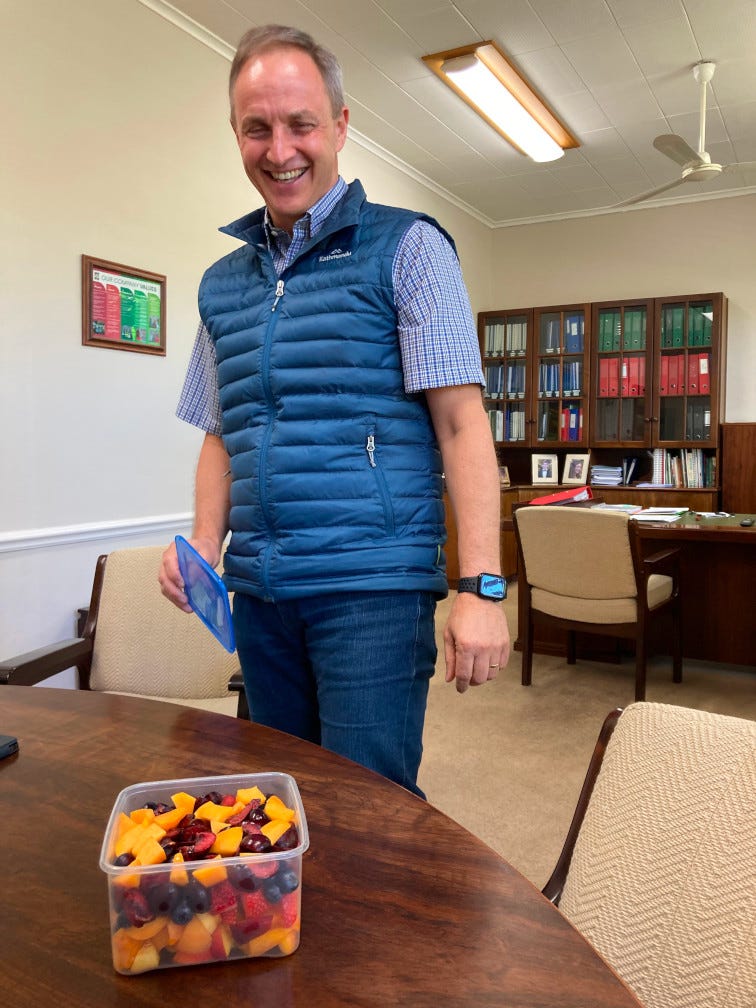
Part of that could be down to the typical farming attitude in South Africa. As van Zyl, who grew up between the towns of Caledon and Napier on a grain, cattle, sheep and dairy farm, says: “If there’s an issue you just get around it and make it work. You make a plan, make another plan, and make five plans.”
New Zealand operates much like that, too, from an ingenuity point of view, he adds. SA competes with NZ in all the markets in which it trades because NZ is also a southern hemisphere country. The distinction in labour costs between the two countries gives SA an advantage considering labour costs on an apple farm constitute roughly 50 percent of total production costs, and both countries are selling in the same export markets at similar USD prices.
For NZ to be competitive as a result, it has to do something different. And that difference has been an on-tree export pack-out of at least 80 percent. It tripled its export earnings within a period of eight years by taking certain varieties out and re-planting new varieties that give it the potential to get to a 70-80 percent on-tree pack-out. “Pack-out” refers to the number of apples on a tree. If there are 100 apples on a tree, for example, 80 of those apples ideally will be good enough to put in a box and export. Currently, in a good year, 45 out of 100 will go into an export box in SA.
“If we want to be sustainable in this industry in the next 20 years, we have to increase our on-tree export pack-out.” Even going from a 45 to 65 percent on-tree export pack-out “will be a game changer from a sustainability point of view,” van Zyl says.
New Zealand’s climate and geographical position latitude wise make it optimal for apple growing conditions, so a variety that will colour well in NZ doesn’t necessarily colour very well in South Africa. “So we have to forever look at better strains of the same variety.
“And that’s the whole thing,” he continues. “You have to get a better strain of a variety to have better colouration – because colour is the thing that makes it either local market or export or juice.”
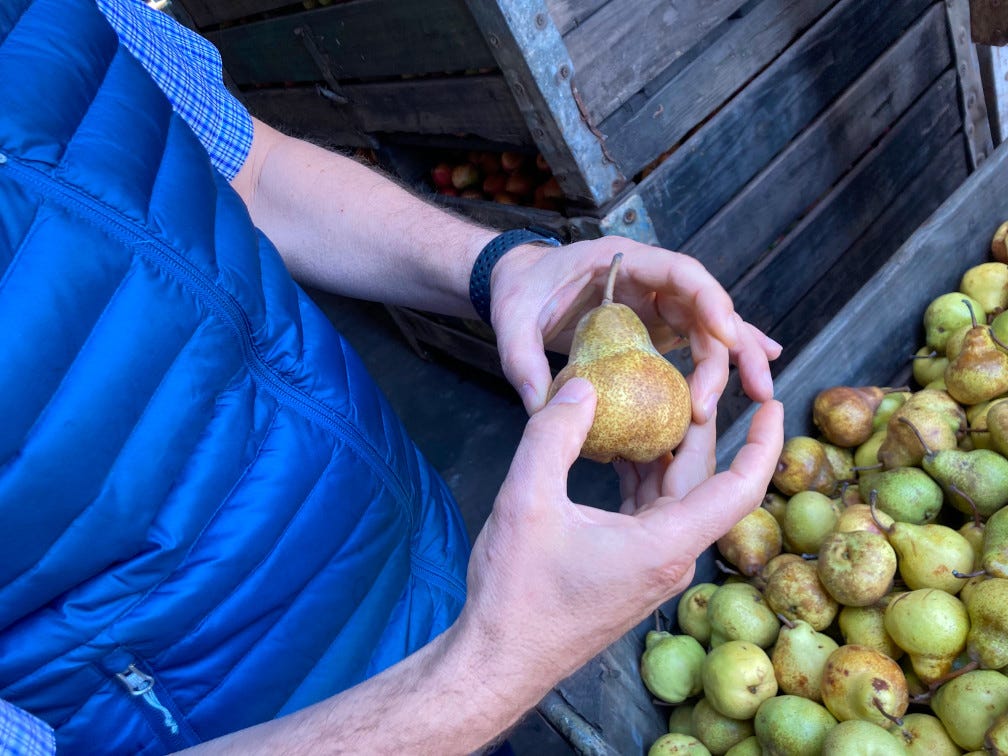
Despite the competition, there are strong industry relationships between the two countries. Two-a-Day has partnered on a new pear variety that’s been developed over the past 25 years in a breeding programme by a farmer in NZ. Called PigaBoo with an orange blush, it’s a pear New Zealand only sells in China. It’s a combination Asian and European pear. Considering what a niche product it is and how difficult it is to grow making yields low, not a lot will be planted locally. Four test orchards were planted in different areas at the end of last year.
“We call it a pear but if you look at the texture and the taste profile and the juiciness, it’s different to what we know as a pear. It’s very special. It’s almost like a new type of thing.”
In general, there are two types of pear processed here: a “summer pear” that has to be picked, packed and immediately shipped; and three pear varieties that can be stored and are stored – some for 10 months, some for two weeks. Summer pears are brought down to zero degrees celsius in the warehouse, and then packed and exported.
Tru-Cape has also bought the rights to plant a new variety that’s been developed by Washington State University in the US. More than 16 million trees have been planted in Washington, a state where 70 percent of apples in the US are grown. Called Cosmic Crisp, 50 hectares of the tree will be planted this year by 20 Two-a-Day growers in Grabouw, Vyeboom, Villiersdorp and Greyton.
The apple has a higher acid level than a Granny Smith which currently has the highest acid level for an apple in SA. But the Cosmic Crisp tastes sweet, “so it’s a very nice balance between crispy, high acid but sweet. I love it,” van Zyl says. It also stores well. The first ones will be available locally possibly in 2026, but definitely in 2027.
Previous rights to foreign apples that have been bought locally include the green apple, Kanzi, from Europe (initially it came from the Netherlands) and the bicoloured apples, Pink Lady and Sundowner, from Tasmania off the Australian coast.

Apples in general will store from a week to 12 months depending on the variety and the marketing plan for that particular variety. There’s all kinds of storage to cater for the various time frames too. Regular atmosphere storage is “like your fridge at home”, van Zyl says. In “controlled atmosphere” storage, on the other hand, there are very low levels of oxygen.
“If a person enters a controlled atmosphere storage facility, 20 seconds and you’ll be dead, so there’s a lot of health and safety regulations around that.” It’s good for storing fruit though, as fruit gets into a state in that environment where it doesn’t degrade.
In the last five to six years, dynamic controlled atmosphere storage drops oxygen levels even lower. The anaerobic conditions stress the fruit and with certain varieties that helps with skin conditions. So Two-a-Day will do this stress-inducing activity once or twice a year – even three times if the fruit needs to be stored for very long.
‘If a person enters a controlled atmosphere storage facility, 20 seconds and you’ll be dead, so there’s a lot of health and safety regulations around that’
Attie van Zyl, Two-a-Day MD
Customers in 100-plus countries are supplied 52 weeks of the year. Southern hemisphere countries such as SA, NZ and Chile supply Europe and the UK for four to six months of the year. During the rest of the year, Europe will have its own supply. The Middle East, Far East and Southeast Asia require a 52-week supply, and Africa too.
Between 15 and 20 percent of exports go to continental Europe, excluding the UK. Within continental Europe, 80 percent approximately will go to Germany. Two-a-Day supplies German retailers: Rewe, Aldi, Lidl and Netto take most of the volume. Seasonality determines what is sent when from a variety harvesting point of view. Germany takes the largest volumes of Pink Lady, Braeburn, Granny Smith and Kanzi, and smaller amounts of Royal Gala. “Their taste profile is much more tangy in general. A very sweet apple is not their typical taste profile.”
The 50 growers of the fruit (from more than 60 farms in a 100km radius) are the owners and shareholders of Two-a-Day and Tru-Cape. Almost 100 years ago, a couple of growers started the Elgin Fruit Company. In 1948 it became a cooperative called Elgin Fruit Packers which consisted of nine growers. In 1993 it changed its name to Two-a-Day Group and from a cooperative to a private company.
The shareholding structure means that if a grower retires, Two-a-Day buys those shares back. One can’t be a shareholder in the company if no longer supplying fruit: the business model is about maximum payments for fruit, not dividends.
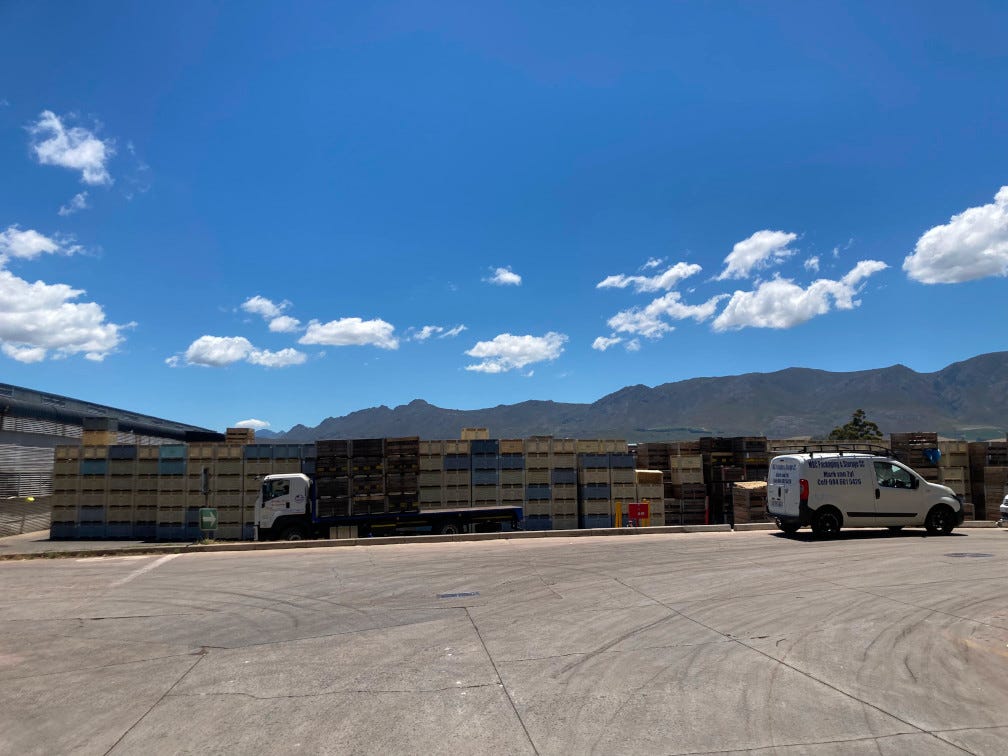
Of all the fruit that’s delivered to the packhouse, of which 80 percent is apples and 20 percent pears, 65 to 70 percent of it is exported. What stays local in SA is determined by cosmetic attributes and colour. There are multiple permutations to consider with incoming fruit: “When do we pack it, for which market do we pack it and how does it fit with the marketing plan?” van Zyl says. “With a lot of retailers all over the world, they want very specific amounts of very specific product in very specific weeks, so you have to fit all of this together.”
Fruit is delivered in 400kg bins. There are roughly 2800 apples in a bin and 2600 pears in a bin. Before fruit leaves the farm, the grower records on a tablet the number of bins, which orchard the fruit comes from and the variety. Once the bins arrive at Two-a-Day, they are driven in the truck through a structure that has cameras at the top and side that work with artificial intelligence to determine what type of bin is inside, such as wood or plastic. If it’s plastic, what type of plastic. Every bin has an identification on it which the camera will scan.
The report could say, for example, that there are 36 bins on that truck but for bin number five, the ID could not be seen. The content of each bin is examined: the sizing of the bin, the colouration, the maturity of the bin in terms of pressures and acidity and starch breakdown and, in terms of the sample that’s been taken, what the export pack-out is of the bin. All of that information is added to the bin ID. Then everything gets washed through a system of chlorine water to get the dust off and then it goes into cold storage.
‘The German population is 80 million people and they have a high per capita consumption of apples and pears. They are an apple-eating country. In Germany, a lot of people have apple trees in their back gardens. Part of the German culture is consuming apples.’
Attie van Zyl, Two-a-Day MD
The bins then move from cold storage to the packhouse or factory. The bin is tipped into a water system and the apples or pears flow out of the bin (“it’s very gentle”). Then a piece of machinery that’s called a sizer takes the weight of every fruit and the diameter of every fruit. Through optical sorting, it looks at the quality of the fruit and does defect sorting; it looks at colouration and it looks at internal quality with infrared.
Every single piece of fruit has approximately 80 photos taken of it; they are strung together. Running eight fruits per line per second based on size, weight, colour and cosmetics, the machine will decide at which packing station to drop which fruit.
“Then you have somebody there who puts them in a box, and those that are put in a box at the station will all look the same.” Some go into bags but most go into a tray that fits in a box. The packhouse employs 2000 workers who are on site 24 hours a day in shifts.
The box then makes its way along a conveyor belt that’s scanned en route. It’s taken by robotic palletiser into a station and palletised from there. Any apple can be plucked from a final product box and have full traceability: which orchard it came from, when it was picked, which picking team or “gang” picked it and who packed it.

“So if Tesco phone us and say we have a bag here with batch code 123, then we must within three hours be able to give them the whole track record: how it was stored, where it was stored, who picked it, from what orchard did it come, what chemicals were sprayed for the whole season in that orchard, when it was packed, when did it go out of the packhouse, when did it go into re-cooling, when it was loaded, on which container was it loaded, which was the shipping line.” All of that information is kept for a season.
Once packed, the fruit goes into re-cooling where the temperature is brought down to zero degrees again. Then it goes into “finished product” which means it is ready to go but waiting to go because of logistics. There are 10 000 pallets of finished product space.
If there are hold-ups at the port and the fruit hasn’t gone when it should have (a common problem in the last few years), after a certain amount of time in finished product, it needs to be reinspected. Often it won’t be able to go to the market it was destined for anymore because it’s by that stage too old. For summer pears that go straight away, as the quickest example, the time between picking and landing in Aldi in Germany, for instance, is three weeks.
The fruit is sent at zero degrees celsius on the ship except for a couple of varieties that are carbon dioxide sensitive; those will travel at just above zero degrees. The container is like a fridge and there is a temperature recorder in each one. And like any fridge, there could be a failure and the container doesn’t run at the right temperature. On average in the past year, this had happened with 2.5 percent of the product.
Now there’s a quality problem and the cost of destroying that container’s fruit is “massive”. “Can it be sold to a wholesaler?” van Zyl says, referring to one of the options that might be considered. Sometimes the fruit is in an international retailer’s branded packaging. “If it’s in Tesco packaging, say, someone needs to unpack it.”
Industry terms mentioned above
RA Regular Atmosphere. Large fridges where fruit is stored at a temperature above the freezing point of fruit.
CA Controlled Atmosphere. Fruit is stored under gas-tight conditions where oxygen is below atmospheric concentration and temperature is just above freezing. The rest of the space is filled with nitrogen.
DCA Dynamic Controlled Atmosphere. A gas-tight refrigerated room where oxygen and carbon dioxide concentrations are managed due to the minimum requirements of the fruit. Controlling units are placed inside the room that measure the chlorophyll-florescence spectrum to determine the level of the gas concentration mix.
Pallet A standardised slatted timber structure on to which cartons of fruit are placed for storage and transport.
Starch The measurement of starch in the fruit that still needs to degrade to sugar. A measure of ripeness.
Marketing them apples
“In Europe, they prefer a big size apple and if you look at our size profile in South Africa, we produce a little bit smaller,” says Roelf Pienaar, managing director of Tru-Cape Fruit Marketing, South Africa’s largest exporter of apples and pears and a business wholly owned by growers.
In Europe and the United Kingdom they eat Pink Lady, Braeburn, Granny Smith, Kanzi, Jazz and Royal Gala: the tangier apple varieties. While apple eaters in the Middle and Far East and Southeast Asia prefer a sweet apple, such as a Golden Delicious or a Fuji.
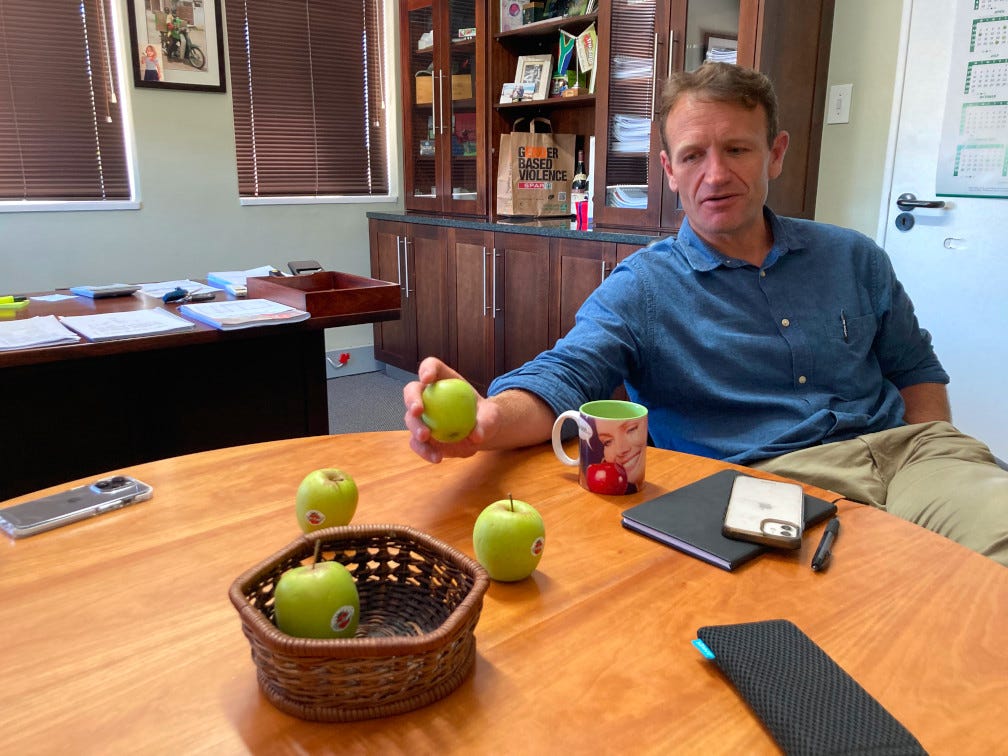
“If you send a variety to a market that doesn’t want that variety, or that size or that colour, the financial impact is severe,” he says, while handling a Golden Delicious from the fruit basket on the table in his office in the town of Somerset West. Tru-Cape sells 80 percent of its Golden Delicious apple harvest in West Africa in countries including Nigeria, Senegal and Ghana.
Aesthetics are a serious component in the selling of apples: it’s not just about green, yellow or red. The russet is the brownish bit on the skin near the stem, and certain markets won’t tolerate the russet going over the “shoulders” of the apple. “The Far East spec, as an example, is a very strict spec: they don’t want a lot of russet. Canada wants russet.”
‘I think the problem with a lot of these new varieties is it may be a fantastic variety – it eats well, it stores well – but you only have it for a limited period of time. If I take a Golden, for example, it’s all year; Top Red, it’s all year. So from a South African consumer point of view, Top Red is king, Golden is king. But there are amazing varieties out there worldwide.’
Roelf Pienaar, Tru-Cape MD
Then there’s packaging and presentation preferences. In South Africa, people buy apples in 1kg or 1.5kg econo bags. In Far East wholesale markets, shoppers will buy pieces of fruit individually. Some international retail customers want the brand stickers on each fruit; other markets don’t want stickers.
“What makes this industry so fascinating is that you work right through the chains,” Pienaar says. “You work with the big retailers, then you work with the second generation guy in Malaysia who started doing business with his dad and now the legacy continues and he’s an apple buyer and he sells it on a corner of the street. We supply both – the retailer, the hawker – some of these guys over the years. I mean, it’s informal trade but they’ve built up massive businesses by selling fruit and veg.”
Selling into 105 countries in Africa, Europe, the UK, North America and the Middle and Far East, he likens sending the fruit to various local and international markets to playing Tetris: “We have to put the different pieces of the puzzle together.”
About 30 of these countries are in Africa: of the total number of bins of fruit produced, 50 percent is sold on the continent. And they’re venturing into new territories such as South Sudan, where previously apples weren’t freely distributed.
In some places in Africa, people have never seen an apple. While in established international markets, apples are a known value item and stored by most supermarkets which means retailers need to keep them on their shelves year-round. “You’re competing with blueberries, you’re competing with cherries. Supermarkets have got all of these varieties and cultivars all year long,” he says.
Apples in South Africa are grown predominantly in the Western Cape province, a little bit in the Free State province, and a little bit in the Langkloof valley in the Eastern Cape province. ‘You need really hot days and really cold nights to get an apple to colour, which makes this area unique,’ he says, referring to the Western Cape, ‘because we can supply the continent. We’ve got this at our doorstep.’
Roelf Pienaar, Tru-Cape MD
Tru-Cape ended the 2022 financial year with 18 million cartons to sell. Pienaar says it had been an “extremely difficult” year for the business and by far the most challenging year for him in his 10 years in the industry, because the European market for the apple and pear business had been very difficult. The Russia-Ukraine war and rising energy prices, inflation and interest rates created a “tsunami of costs coming through”, including freight rates which went up by as much as 40 percent.
“You had a very hot European summer as well which did not help with consumption of apples. People didn’t want to eat apples, they wanted to eat ice cream in our winter months – in the northern hemisphere at that time.
“This product doesn’t last forever,” he adds, referring to fruit. “Once you’ve harvested it, the clock starts ticking and you have to sell it.”
Industry terms mentioned above
Econo bag A low-density polyethylene bag that is easily recyclable in which apples and pears are sold. Also known as a thrift bag.
Carton The cardboard box in which trays of loose fruit or bags of fruit are transported.

A variety of varietals
The major apple varieties produced in South Africa and exported are Golden Delicious, Royal Gala/Gala, Granny Smith, Top Red/Starking, Braeburn and Fuji. Relatively new varieties produced and exported in South Africa include Cripps Pink and Pink Lady, Cripps Red/Joya and Kanzi.
A Cripps Pink is a lighter-coloured Pink Lady. When Cripps Pink is the right colour, i.e., a darker shade of pink, it gets packed in a Pink Lady box and sold in Europe. Growers struggle to get the right market prices for Cripps Pink so from a farming perspective, they would aim to get as much Pink Lady out of a bin as they possibly could, according to Pienaar. Cripps Red is the apple harvested the latest.
“You get varieties and then you get profitability,” he says, referring to the number of items you can pack out in a bin and export. “I’ve seen now it’s very tricky to plant a variety for a specific market.”
Once a tree is planted, it takes about six years for the tree to be at optimum producing level. “Keep in mind that a varietal is a long-term investment for a grower. It’s very difficult to know what’s going to be the taste profile in 10 years’ time, or in five years’ time,” Pienaar says. Even though taste profiles in various geographic areas tend to remain steady, one can’t account for geopolitical events that will affect sales and exports.

Tangy vs sweet: the main divide in apple tastes globally
Granny Smith, the grass green staple of the apple world, is acidic and widely used in cooking and baking. In the 1980s and 90s, it was the main apple planted in South Africa. The most popular tangy now in SA could be Braeburn, Griessel says. The Bradley in the UK is the most popular there while Honeycrisp in the US is the most popular there, but that’s more of a combo sweet-tart taste.
The Golden Delicious is medium sweet; the Gala is on the sweetish side and widely planted all over the world – like “a semi-sweet wine”, Nel says.
In the Far East they go for the red and yellow Fuji, which is as sweet an apple as they come. The biggest consumers of apples are the Chinese and they plant the most, too, so by that gauge the most popular sweet apple worldwide is a Fuji, Griessel adds. “The Chinese only eat sweet apples: that’s Fuji.”
Pienaar says Fuji is planted in South Africa for that market: “In theory when they run out of fruit, we supply them.” The Middle East and Southeast Asia – countries including Singapore, Malaysia, Vietnam, Bangladesh and Cambodia – also prefer a very sweet apple.
West Africans similarly have a sweet taste profile while East Africans have a tangy taste profile. “So you are not able to sell a sweet apple in East Africa. It’s very interesting,” van Zyl says.

